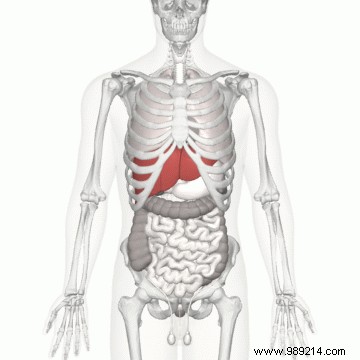According to new research, as the human body ages over time, the liver manages to stay young thanks to the regeneration of its tissues. On average, the organ would be less than three years old, regardless of the age of the person it is attached to. Details of the study are published in the journal Cell Systems.
One of the main functions of the liver is to remove toxic substances from the body. This process wreaks havoc on the organ, but it is able to generate new tissue functional in response to these injuries. This process is essentially based on the proliferative capacity of liver cells.
We know that the physiological replacement of liver cells is essential to maintain the high metabolic activity of the liver. However, these characteristics have always been difficult to study in humans. For example, it was previously unknown whether parenchymal hepatocytes are constantly exchanged throughout life or whether they are physiologically long-lived cells. This is particularly the case for cardiomyocytes and neurons, which maintain structural and functional integrity over several decades.
To try to find out, researchers used mathematical modeling and a technique called retrospective radiocarbon birth dating. This method involves dating human cells based on levels of a carbon isotope that peaked in the atmosphere after nuclear testing in the mid-20th century.
For this work, the team led by molecular biologist Olaf Bergmann, from the Dresden University of Technology (Germany), relied on tissue samples post -mortem and biopsies taken from more than fifty people . All were between 20 and 84 years old .

As our body ages, it is less able to renew cells and make repairs. What this new study shows is that this wasting does not apply to hepatocytes (liver cells). Our body maintains control over liver mass throughout our lives through the continuous replacement of these cells. This process allows this organ to remain a young organ:it would be a little less than three years old on average.
However, not all liver cells are alike. Some live longer than others. This difference in turnover rate seems to be related to the ploidy level . This is the number of copies of complete sets of chromosomes in the genome. "Diploid" cells have two, while so-called "polyploid" cells have at least three.
Here, the authors noticed that diploid hepatocyte cells showed annual birth rates more than seven times higher to polyploid cells. In other words, the former are renewed much more quickly than the latter. These observations thus support the idea that the physiological renewal of hepatic cells in humans depends mainly on diploid hepatocytes , while polyploid cells are compromised in their ability to divide.
This is important new insight into the biological mechanisms that underlie liver function. These works are naturally important. The more we know about this vital organ, the better we can understand how to keep it healthy or cure it of disease.